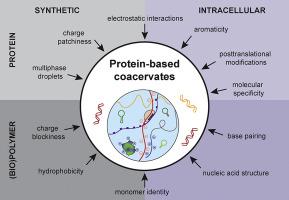Current Opinion in Colloid & Interface Science ( IF 7.9 ) Pub Date : 2020-12-16 , DOI: 10.1016/j.cocis.2020.101407 Rachel A. Kapelner , Vivian Yeong , Allie C. Obermeyer

|
Protein–polyelectrolyte coacervates have gained interest for their potential to stabilize proteins or function as adhesives and their biological implications in the formation of membraneless organelles. To effectively design these materials or predict their biological formation, knowledge of the macromolecular properties that dictate phase separation is required. This review highlights recent advances in the understanding of molecular determinants of protein–polyelectrolyte phase behavior. Properties that promote the phase separation of protein–polyelectrolyte pairs are covered from the perspective of synthetic systems and simplified biological condensates. Prominent factors that determine coacervate formation and material properties include nonspecific intermolecular interactions, as well as specific biological interactions and structures. Here, we summarize the essential roles of electrostatics, including charge magnitude and distribution, (bio)polymer chemistry and structure, and post-translational modifications to protein phase separation in both a synthetic and cellular context.
中文翻译:

蛋白质凝聚层的分子决定因素
蛋白质-聚电解质凝聚层因其具有稳定蛋白质或充当黏合剂的潜力及其在无膜细胞器形成中的生物学意义而受到关注。为了有效地设计这些材料或预测其生物形成,需要了解决定相分离的大分子特性。这篇综述突出了对蛋白质-聚电解质相行为的分子决定因素的理解的最新进展。从合成系统和简化的生物冷凝物的角度,涵盖了促进蛋白质-聚电解质对相分离的特性。确定凝聚层形成和材料性质的突出因素包括非特异性分子间相互作用,以及特定的生物学相互作用和结构。这里,











































 京公网安备 11010802027423号
京公网安备 11010802027423号